Yūrei-zu: Japanese Horror in Art
Some Asian cultures are notorious for their rich horror culture, showcasing exceptional horror movies and artistic expressions that continually...
Errika Gerakiti 11 April 2024
Enlightening and radiant bodhisattvas are often depicted in art. With the opening of Buddhist practice to laypeople, active and compassionate bodhisattva archetypes developed in the popular imagination through artistic imagery. These archetypes were not remote or passive: they had a very human feel to them. They were involved with the world, with you and me, and with all beings around them.
The bodhisattvas blossomed like fine flowers, filling the world with kindness, compassion, wisdom, and joy. A bodhisattva is a person who is on the path to Buddhahood. They have compassionate minds for the benefit of all sentient beings. Bodhisattvas turn their hearts towards us and aspire to end suffering. They are constantly trying to find the means to help others. However, they do not ask for anything in return. Their actions inspire us.
The word bodhisattva comes from the Sanskrit bodhi, meaning “awakening” or “enlightenment,” and sattva, meaning “sentient being”. Myth and psychology fuse in these beings and they often appear in Buddhist art. The major bodhisattvas embody various aspects of enlightened activity. Their presence points to guiding principles for a more compassionate world. Thus, they are forces for well-being in our lives.
In early Indian and later Buddhist traditions, including Theravada, a bodhisattva was primarily referred to Buddha Shakyamuni in his former lives. The Jataka Tales portray his efforts in past lives as a bodhisattva to cultivate qualities such as morality, self-sacrifice, and wisdom, which will later define him as a Buddha. For example, one of the Jatakas tells the story of a compassionate prince, Vessantara. He gives away everything he owns, thereby displaying the virtue of perfect generosity.
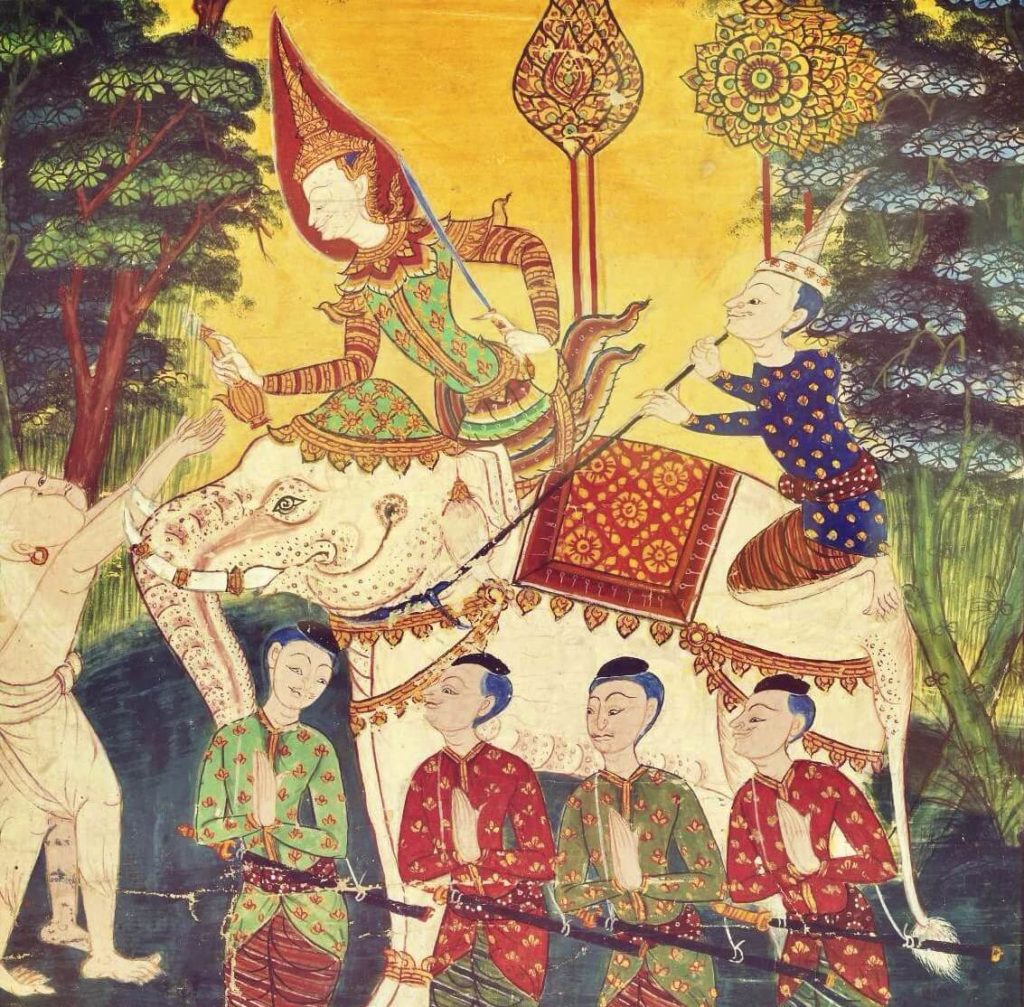
In this scene, Prince Vessantara is giving his prized white elephant to a group of brahmins, protectors of sacred learning, from a neighboring kingdom. A white elephant was believed to bring rain and prosperity. Vessantara sits atop the elephant, surrounded by symbols of his royalty. He pours water into the brahmins’ hands as a sign of the gift being given.
As a faith, Buddhism made a great leap from India through Central Asia to China. Initially, a branch of Buddhism called Mahayana developed in Northwest India. It was an area influenced by a sequence of powers. There was also some development in South India, the region in which Nagarjuna (150–250 CE), one of the most important Buddhist philosophers, lived.
In the period between 100 and 400 CE, there was widespread commerce among several regions in Asia, including China. At that time, the Chinese had their own religious traditions. They struggled to make sense of the wide range of Buddhist teachings, sutras, diverse schools, and ritual forms. Eventually, Chinese schools of Buddhism emerged. Each school built its own system for classifying Buddhist texts. Soon, Korea and Japan adopted Chinese teachings.
In these countries, thinkers further developed Mahayana, or the “Greater Vehicle” of Buddhism. According to this system, throughout the history of the universe, many have committed themselves to becoming Buddhas. Consequently, a broad range of potential Buddhas inhabits the universe. Some of these bodhisattvas have just embarked on the path to Buddhahood, while others have spent lifetimes in training and have acquired supernatural powers.
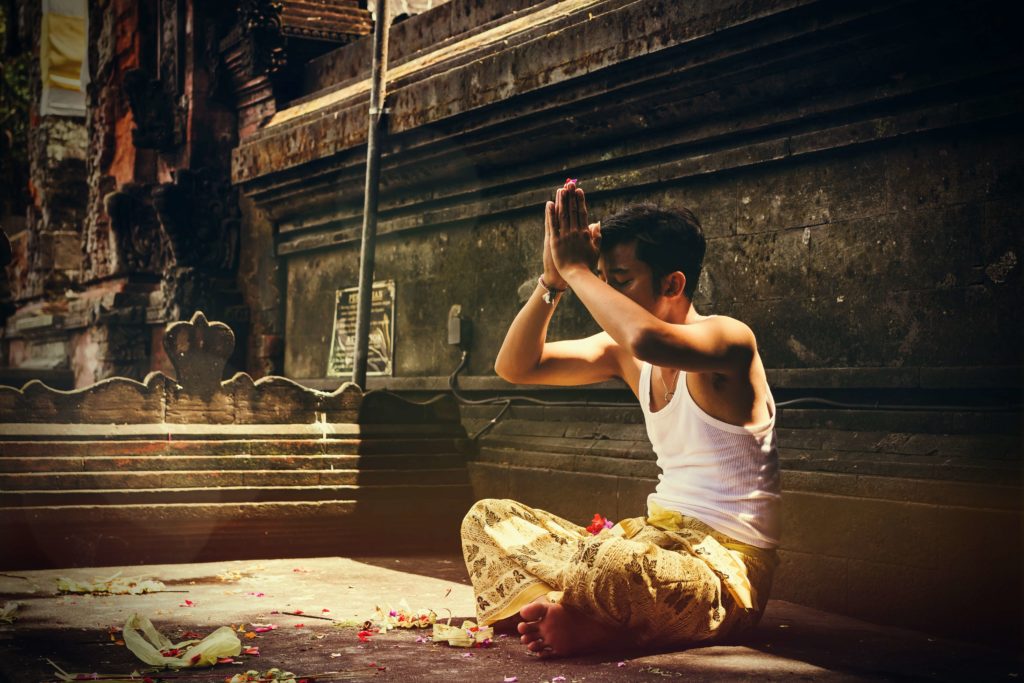











Since Mahayana promoted the universal liberation of all beings, the bodhisattva ideal was at its core. Bodhisattvas vow not to settle into the salvation of final Buddhahood until they assist all beings to fully realize this liberating experience. As a result, the imagery of a bodhisattva widely appears in Buddhist art. Many countries throughout Asia have left an artistic legacy of Mahayana. Today, this branch of Buddhism is still popular in China, Japan, Korea, Mongolia, Tibet, and Vietnam.
Bodhisattvas can be awesome in their power, radiance, and wisdom. However, they can take many appearances. Some of the bodhisattvas are mythical figures, others are based on actual persons. They can be as ordinary as your next-door neighbor. Everyone has the capacity to act as a bodhisattva. Furthermore, at times, everyone acts kindly as a bodhisattva. Anyone can take the bodhisattva path.
A key aspect of bodhisattva practice is the commitment to the way of awakening. Then, a bodhisattva carries out this commitment for the benefit of all. This state of mind and intention is known as bodhicitta or “enlightening mind”. The Buddhist scriptures give various descriptions of the bodhisattvas’ development of character, from this first impulse until the fulfillment of Buddhahood. The commitment to awakening appears in bodhisattva vows, some of which are specific. For example, one can vow to alleviate a social problem or to help in a situation of personal suffering within one’s reach.
There are also general bodhisattva vows common to all Mahayana practitioners. The best known are the four vows. In Zen monasteries, monks usually chant these vows at the end of daily services.
Living beings are infinite, I vow to free them. Delusions are inexhaustible, I vow to cut through them. Dharma gates are boundless, I vow to enter them. The Buddha Way is unsurpassable, I vow to realize it.
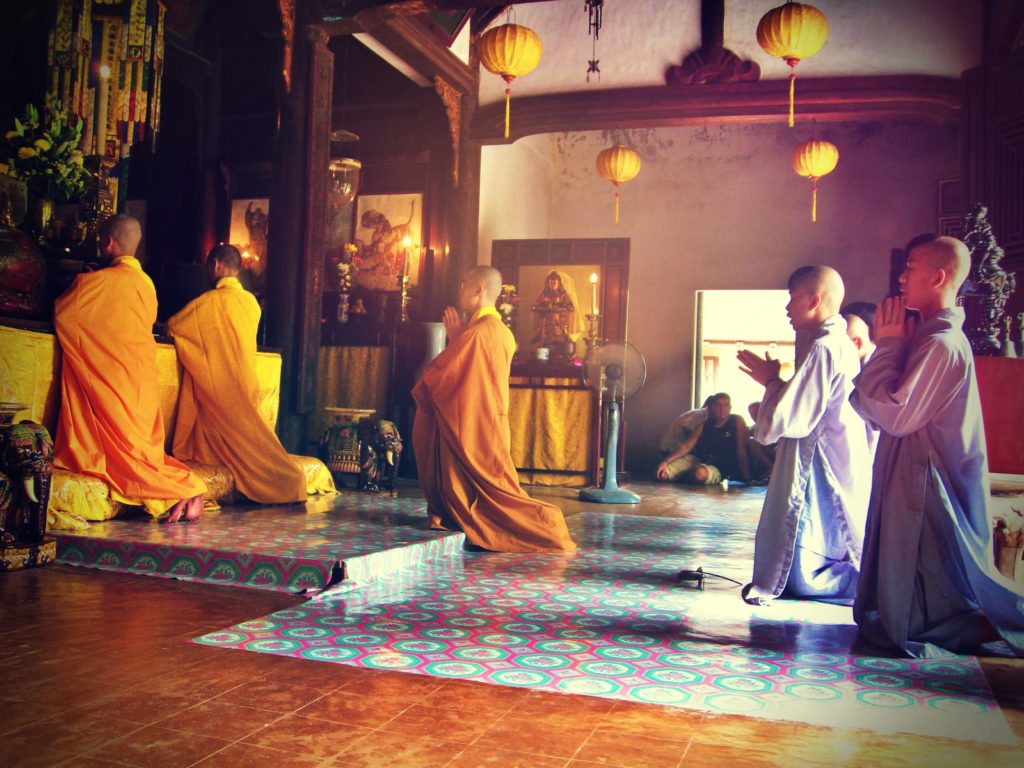











These vows seem impossible in terms of the conventional perspective on the world. However, through these words, the bodhisattva activates the universal level of commitment. At the same time, this being can display ordinary kindness that we all may perform in our everyday lives.
All beings have the Buddha nature expressed in the first vow. The nature of reality is already present and always available to everyone. However, we are obstructed from realizing and enjoying this reality and then embodying it. This obstruction comes from our confusion, our grasping, and our aversion. It derives from the complex web of psychological and cultural conditioning. Therefore, our task is to let go of the attachments that block our inherent freedom and radiance.
The second vow is about cutting through delusions, living simply, and needing less. This increases the richness in our lives more than accumulating wealth. At the same time, seeking to rid ourselves of all desires, we create just another desire.
The third vow, to enter the boundless dharma gates, points to the richness of the teachings about how to live most fully. The word dharma has several meanings, which include “truth” or “reality” itself. In the Buddhist context, dharma indicates the teachings about that truth.
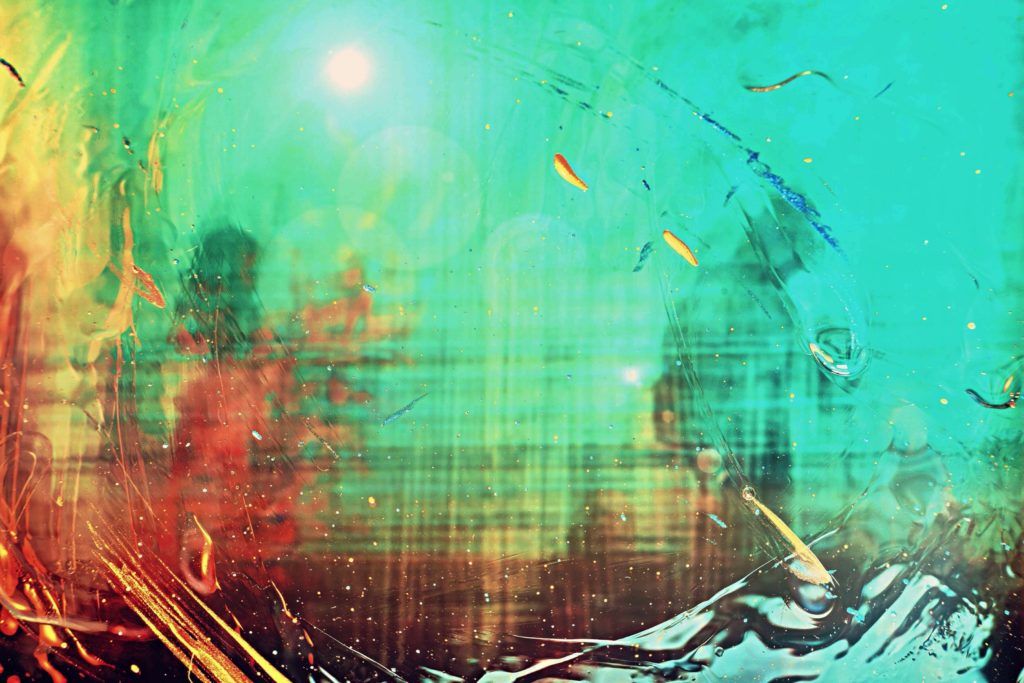











These gateways are boundless because the opportunities for finding teaching are numerous. Therefore, the bodhisattva studies all the gateways to reality, using whatever systems or approaches may be helpful, developing the tools to act effectively. Each person and every situation we encounter has something to teach about how to be more fully ourselves.
The fourth vow, to realize the unsurpassable Buddha Way, emphasizes the experiential side of the bodhisattva ideal. The bodhisattva teachings are not a doctrine or an object of belief. The point is to fulfill the bodhisattva’s intention in our own situation. For example, we may recognize our present shortcomings and lack of awareness. Nevertheless, we can forgive and dedicate ourselves to making the reality of universal awakening.
We may aspire to become a bodhisattva. At the same time, this enlightened being can be someone who we hope to meet or invoke. Traditionally, artists created images of a bodhisattva with symbols so that devotees can petition these figures to come and give personal aid and support. Moreover, one of the sutras promises that believers need only call out the name of Avalokiteshvara and this bodhisattva will arrive to rescue the faithful.
In art, bodhisattvas have attributes that can help us to tell them apart. For example, we can distinguish the images of a bodhisattva from those of the Buddha by what they wear. The Buddha generally appears without jewelry and with less elaborate clothing.
In contrast, artists depict bodhisattvas in luxurious clothing. These enlightened beings can wear jewelry, diadem, earrings, necklaces, armlets, bracelets, and anklets. For example, in this gilt bronze sculpture, a standing bodhisattva Vajrasattva, commonly associated with the student practitioner, wears an ornamental headdress and jewelry and holds vajras or ritual weapons in his hands.
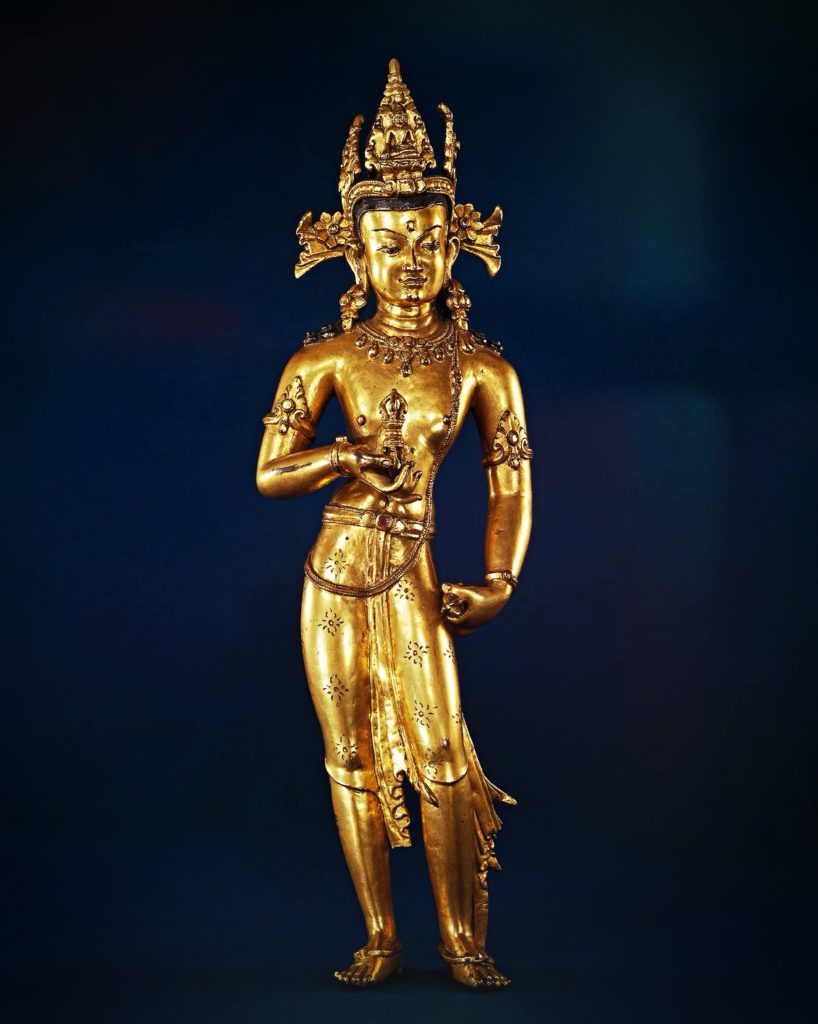











Usually, bodhisattvas have benevolent and peaceful appearances. However, at times, they take the wrathful form, which should not be taken literally. Looking deeper, his form symbolizes the spirit and energy that a bodhisattva possesses to trample negativity or cut through ignorance.
Buddhist art is full of jewels. In Buddhism, the jewel, or cintamani, signifies the Buddha and the Doctrine through its luminosity. Since a pearl is an emblem of purity, it stands for the truth of the Buddha and the Law. Bodhisattvas can also hold the vajra, a weapon used as a ritual object. It symbolizes both the properties of a diamond, its indestructibility, and a thunderbolt or irresistible force.
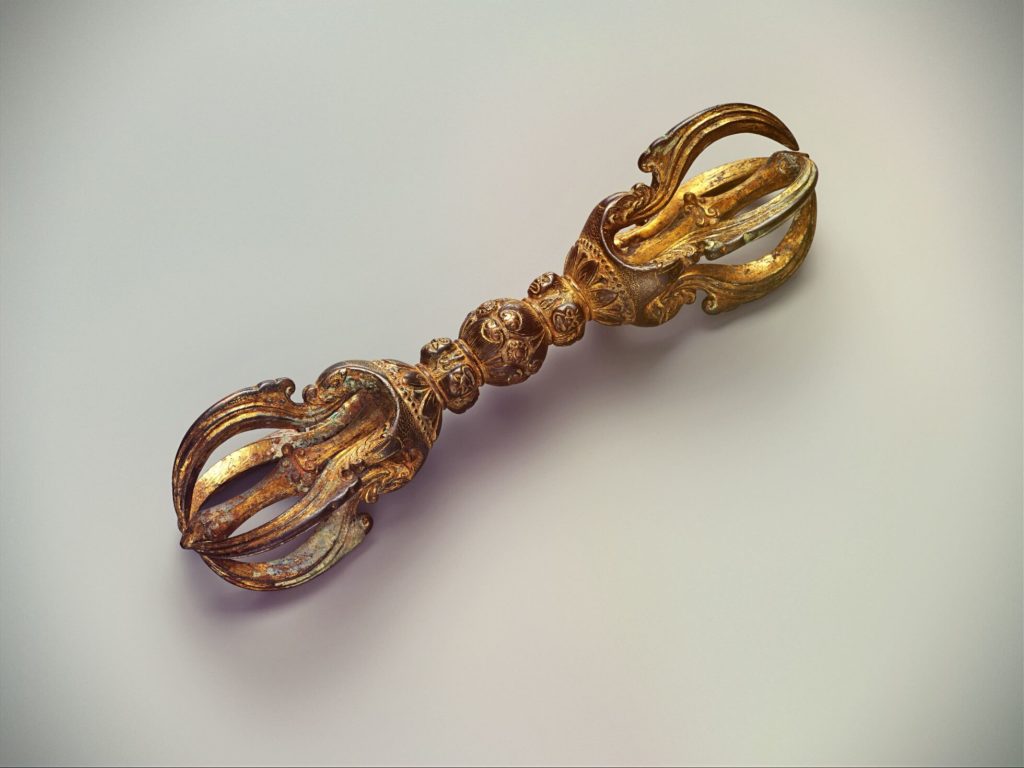











Although many bodhisattvas are mentioned in Buddhist sutras or texts, the Eight Great Bodhisattvas are most commonly represented in art. Each of these bodhisattvas has an important role in helping other beings to attain enlightenment. They all have the power of compassion, however, as archetypes, they also represent one of the virtues.
Different bodhisattvas embody sutras, schools, and branches of Buddhism. Furthermore, they have mountains or other sacred sites dedicated to their worship. They can also inhabit specific paradises, such as Sukhavati or Western Pure Land of Bliss. In this land, resides the Buddha Amitabha, one of the celestial Buddhas who have always existed from the beginning of time. There, he sits on a lotus in the middle of a terraced pond, surrounded by eight great bodhisattvas.
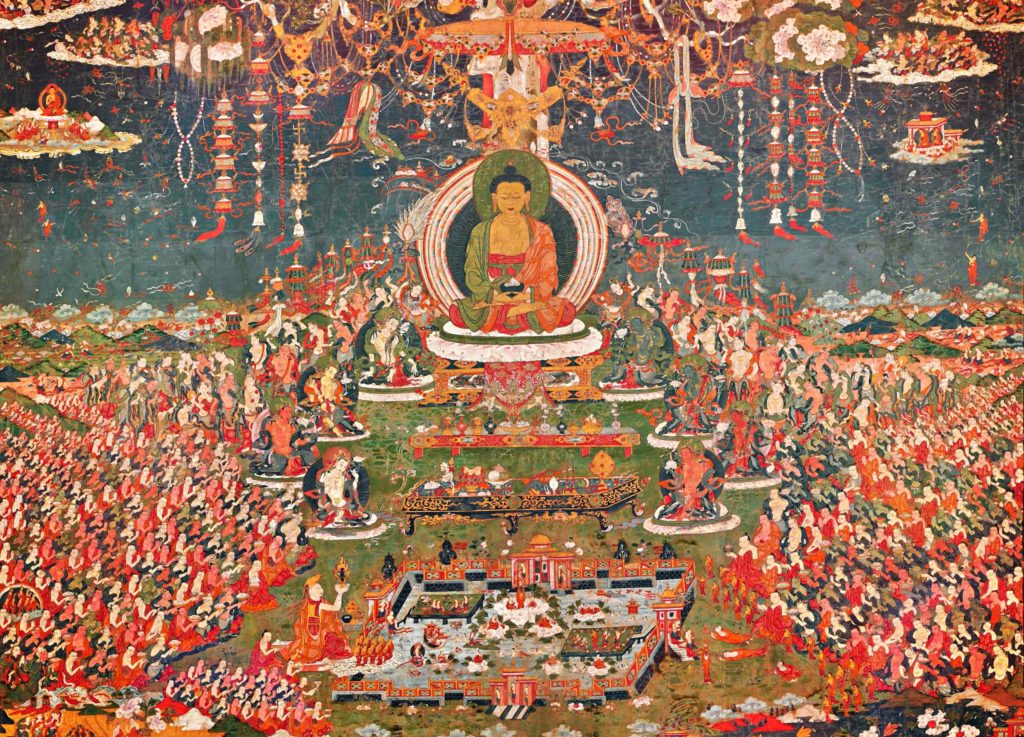











Although the lotus grows in mud, it rises to the surface of the water to bloom. It symbolizes purity and perfection, indicating that the deity seated upon it has attained a state of enlightenment. It also signifies the possession of universal compassion. Staying actively engaged with the world, the deity can bring salvation to all beings. Therefore, the lotus throne or lotus flower often appears in the images of a bodhisattva.
Bodhisattvas can also ride different animals, such as lions, elephants, horses, and peacocks. They can also have hand gestures or mudras that can help us to identify these beings. Furthermore, the objects that bodhisattvas hold represent a concept. For example, a sword could imply cutting through ignorance. The wheel means the perfection of the dharma or the Buddha’s teaching.
Avalokiteshvara is the bodhisattva of compassion. His name can be interpreted as one “who looks in all directions” or one “who hears the world’s cries.” Although all bodhisattvas act compassionately, Avalokiteshvara is considered the embodiment of the abstract principle of compassion.
According to the Lotus Sutra, Avalokiteshvara can take any form that enables the deity to alleviate suffering. Moreover, bodhisattvas are not archetypes of men or women, but of all human beings as positive spiritual agents. Therefore, some of the major bodhisattvas are traditionally androgynous, and Avalokiteshvara can appear in both male and female forms. In China, in her female form, she is the “Goddess of Mercy” or Guanyin, while in Tibet, he is called Chenrezig. In Japan, followers know him as Kannon.
This sculpture exemplifies the artistic ideal of the Tang style. The fullness of bodily form is borrowed from classic Indian sculptural art of the Gupta period (320–550 CE). Avalokiteshvara has a sympathetic demeanor shown in the slight tilt of the head.
Furthermore, the bodhisattva is seated in the relaxed posture of “royal ease” or lalitasana. He wears an elaborate, flowing robe and a string of jewels. His right hand is in the gesture of offering or varadamudra. Guanyin holds one of several ribbon-like scarves, while his left hand points downward.
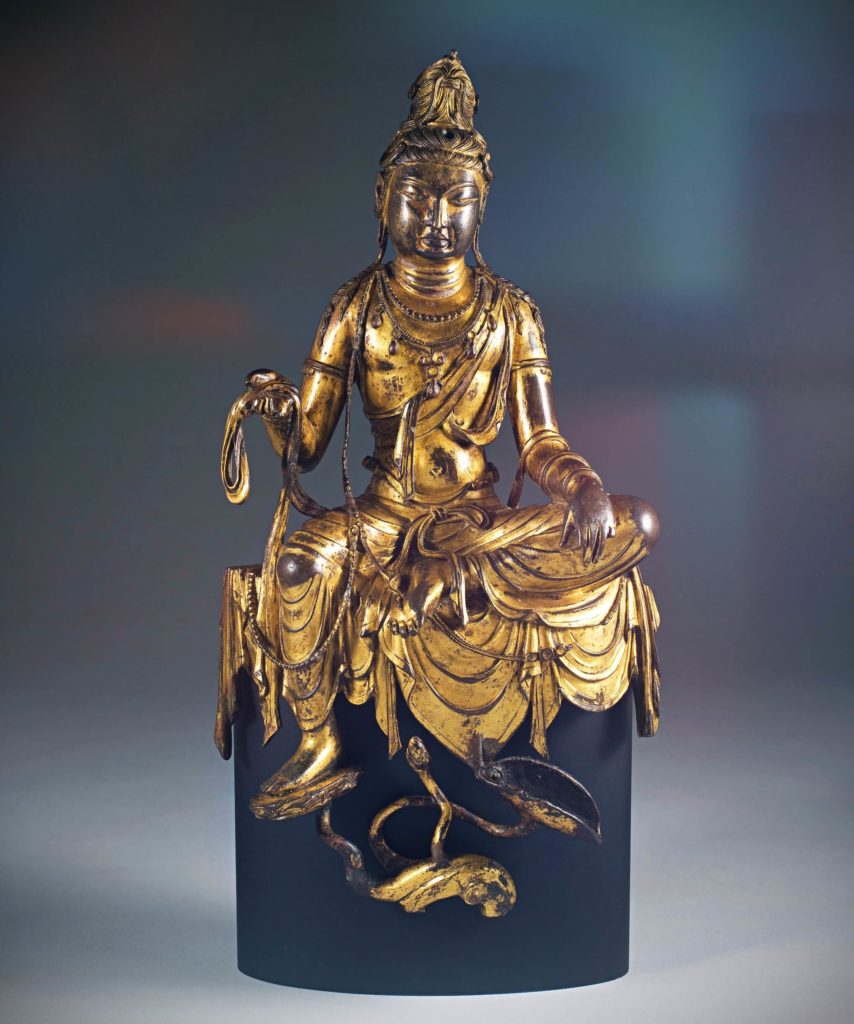











Sometimes, Avalokiteshvara can have a thousand hands and eyes. The deity has this form because Avalokiteshvara had vowed to save all sentient beings. One day, looking down into hell, she saw the immense number of beings who needed to be saved. Overwhelmed by grief, her head split into eleven, and her arms broke into one thousand pieces.
However, Amitabha, the Buddha of Infinite Light, transformed the pieces into eleven heads and one thousand arms. Therefore, with her many heads, Avalokiteshvara could hear the cries of the suffering everywhere. With his many arms, she can reach out to help many beings at the same time.
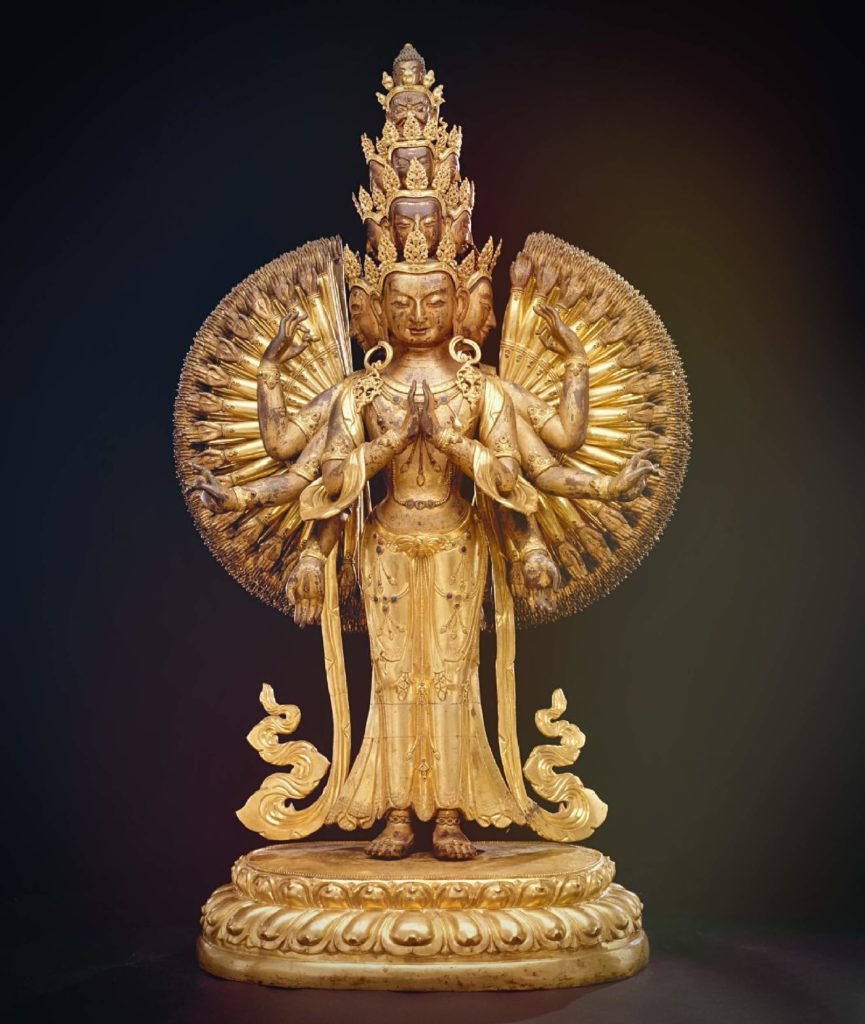











Owing to this story, artists sometimes depict Avalokiteshvara with eleven heads and many arms. Sculptors make each of the thousand arms individually. Alternately, they can fuse the arms into a single mandorla or an almond-shaped areola.
Usually, the hands have eyes inscribed on the palm. This signifies greatly expanded sight and enhanced capacity for action. An astonishing array of eyes and hands surrounding the standing bodhisattva symbolizes a limitless gaze and infinite reach, encompassing the entire universe.
Manjushri is the bodhisattva of wisdom who explains the fundamental emptiness or true nature of all things. In Sanskrit, Manjushri means “Gentle Glory”. He is the celestial embodiment of prajna, the Buddhist value of discriminating wisdom and insight. This wisdom is necessary to break free from ignorance and reach enlightenment.
This bodhisattva often rides a lion and wields a sword, which he uses to cut through delusion. Manjushri sits at the center of Zen meditation halls, encouraging deep introspection and the awakening of insight. Although he is depicted as a young prince, he may manifest as a beggar.
In this sculpture, Manjushri appears in his two-armed form. His youth shows the freshness of growing insight on the path to enlightenment. He has a calm appearance and holds divine attributes. Manjushri is also adorned with jewelry and has a formal posture. This bodhisattva is seated in the vajra position. His knees are firmly on the ground and his ankles crossed, his back perfectly straight, and his head titled slightly to the left.
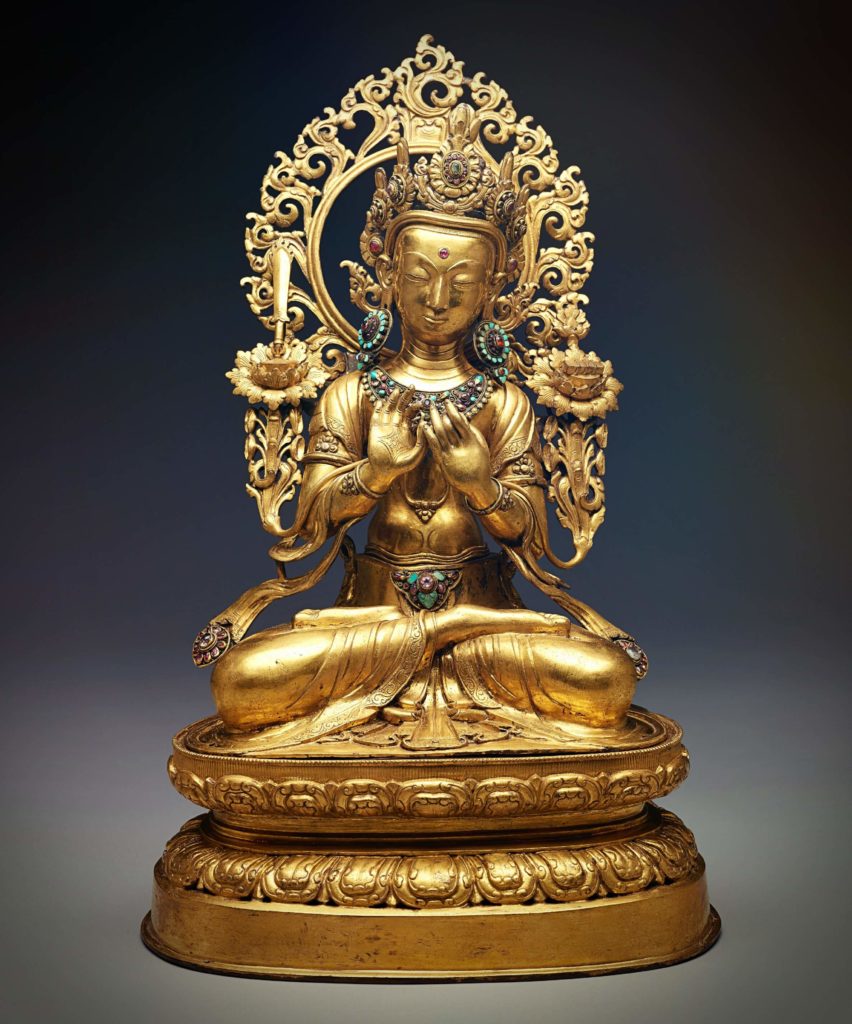











He holds his hands in the teaching gesture or dharmachakra mudra. The stems of lotus blossoms are next to each shoulder. On Manjushri’s right, the lotus supports his flaming sword of wisdom that cuts through ignorance. The lotus on his left holds Prajnaparamita sutra, a scripture that signifies his mastery of prajna.
Some Tibetan figures of Manjushri show him holding the sword in his right hand and the book in his left. The lotus blossom above the shoulder allows the deity to hold his attributes while also showing the symbolic mudra. The halo of stylized flames surrounds Manjushri’s head.
Samantabhadra is the bodhisattva of enlightening activity in the world. He represents the Law of the Buddha. His name means “Universal Worthy,” referring to his fundamental goodness. Therefore, he is the patron and protector of the Lotus Sutra. Samantabhadra is not subject to limits of time, place, or physical conditions.
He is the unity of awareness and emptiness, the unity of appearances and emptiness, the nature of mind, and natural clarity with unceasing compassion. Samantabhadra often appears in a triad with the Buddha and Manjushri. He usually rides an elephant either with three heads or with one head and six tusks. Symbolically, these six tusks represent the paramitas or six perfections. These are charity, morality, patience, diligence, contemplation, and wisdom.
In China, Samantabhadra is the patron deity of Mount Emei, a picturesque location in Sichuan province. It is one of the Four Sacred Buddhist Mountains of China. The first Buddhist temple was built in this area in the first century CE. The site has seventy-six Buddhist monasteries of the Ming (1368—1644) and Qing (1644—1912) dynasties, most of them near the mountaintop.
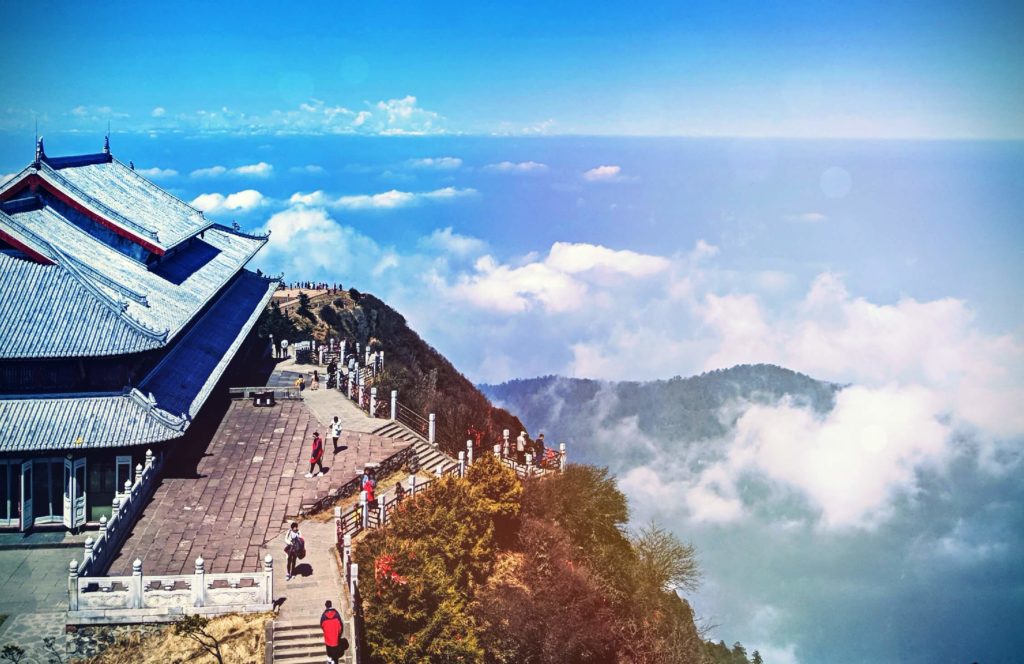











The monasteries on this site have a flexible architectural style that adapts to the landscape. For example, some are built on terraces of varying levels, while others are raised on stilts. Here, the builders modified the fixed plans of temples of earlier periods to make full use of the natural scenery.
In the painting, Buddha Vairocana is seated on a lotus-flower throne in heaven. He is the source of the entire universe. His right hand is in the teaching gesture or dharmachakramudra. On either side are Buddha Vairocana’s attendants, the bodhisattvas of wisdom and universal virtue. Manjushri rides a lion and Samantabhadra sits on a six-tusked elephant. Sometimes, artists depicted Samantabhadra with a feminine appearance. His name in Chinese is Puxian and in Japanese, Fugen.
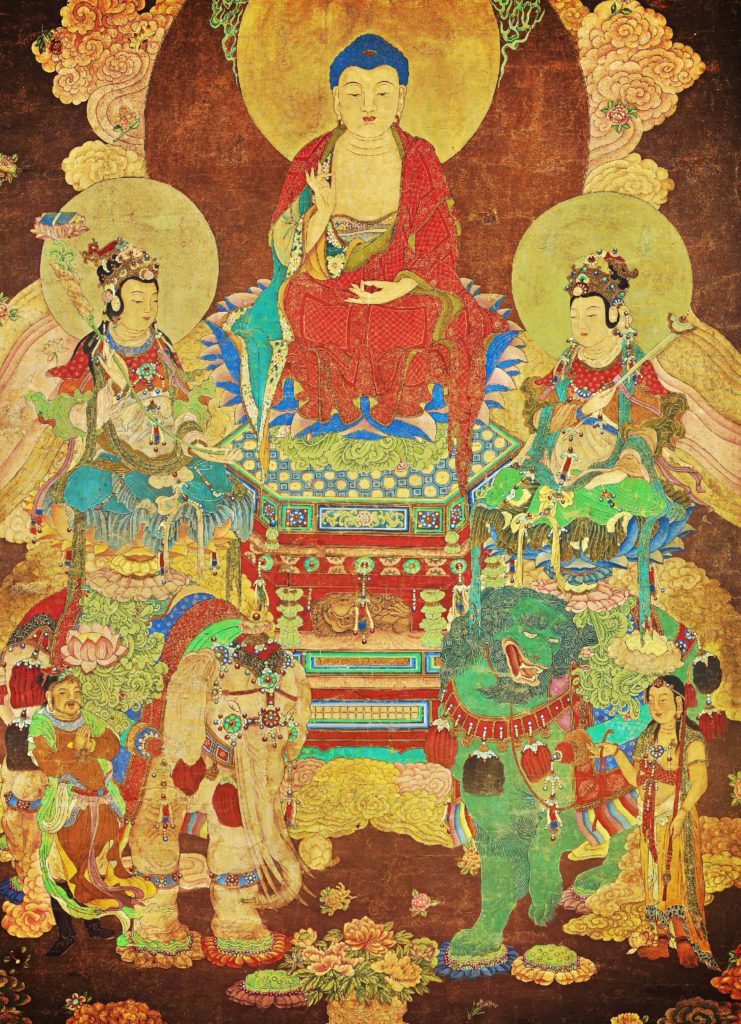











This trinity or the Three Saints of Huayan is described in the Flower Garland sutra. This group received this name because the Buddha’s enlightenment is like a floral crown. Therefore, this painting is similar to “the rain of flowers in the Buddha-land.”
Kshitigarbha is of lesser importance than the other bodhisattva archetypes in terms of philosophical doctrine. His name translates as “Earth Womb” or “Essence of the Earth”. He is the savior of the oppressed and the dying. Kshitigarbha has vowed not to stop his labors until he has saved the souls of all the dead condemned to hell. In China, people believe that Kshitigarbha or Dicang is the overlord of hell. He is usually invoked when someone is about to die. In Central Asia, he often appears on temple banners.
However, In Japan, Kshitigarbha or Jizo does not reign over hell. Instead, people venerate him for the mercy he shows to the departed. In particular, he displays his kindness to dead children. Therefore, Jizo is associated with ceremonies for deceased children. His statues are a common sight, especially on roadsides and in graveyards.
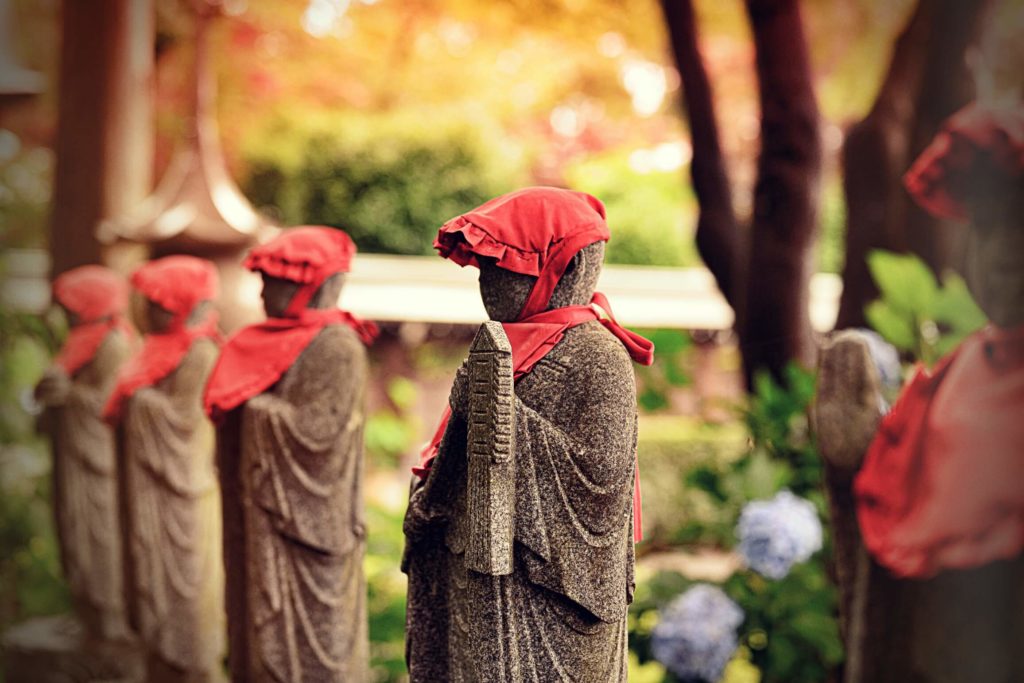











The images of Jizo are often commissioned by bereaved parents in the hope of relieving their deceased children’s labors. According to the story, children who die go to the underworld as punishment for causing sorrow to their parents. Eventually, they reach Sai-no-Kawara, the riverbed of souls in purgatory.
There, they build stone towers, hoping to climb out of limbo into paradise. However, soon hell demons arrive, scatter their stones, and beat them with iron clubs. At this moment, Jizo consoles the children and hides them in the wide sleeves of his robe, thus saving them.
Even today, mourning parents cover Jizo statues in pebbles. They believe that every stone tower they make will help the soul of their dead child in performing his or her penance. Parents can also cover Jizo statues in red caps or bibs. In Japanese belief, red is the color for expelling demons and illness. This bodhisattva is also believed to aid women wishing to conceive and is the patron deity of travelers.
In the sculpture, Jizo takes the guise of a monk with a shaved head. He has an urna, or dot between his eyebrows as a sign of wisdom. The bodhisattva holds a jewel or chintamani in his left hand. In his right hand, he carries a monk’s staff or khakkara with six rings that jingle to announce his arrival.
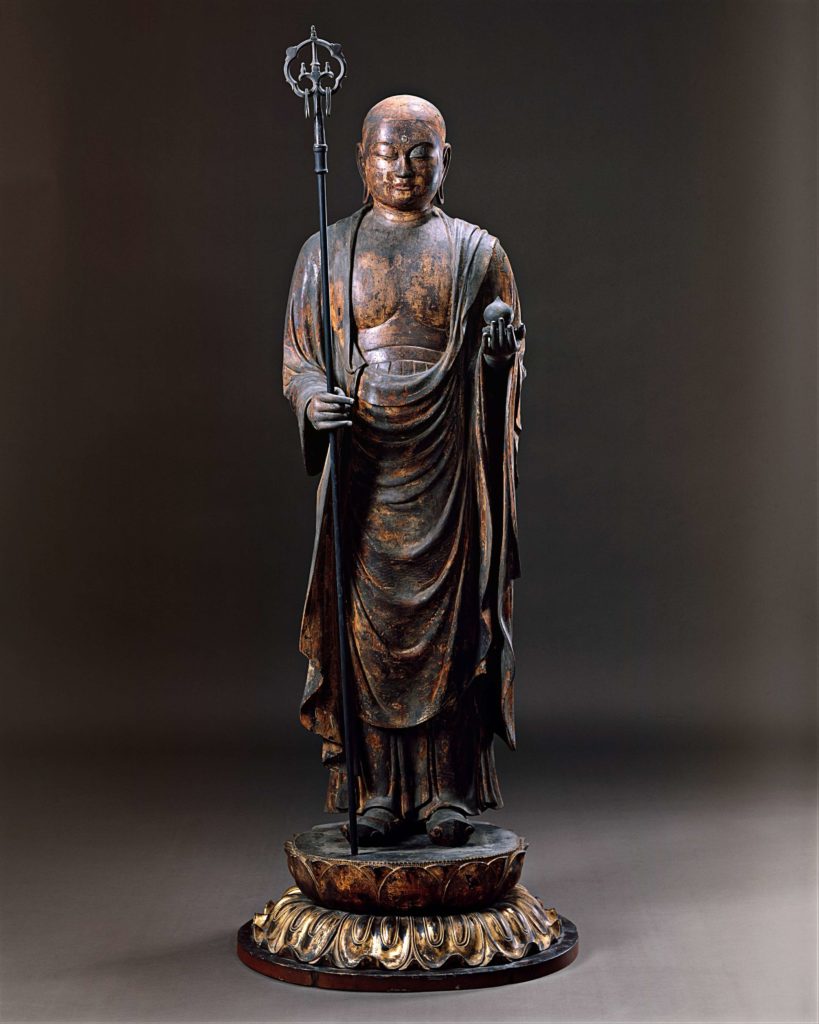











From hell to paradise, Jizo’s compassionate presence illuminates the way. He saves those who call out to him from harm. The flowing movement of the garment reflects an artistic style popular in the early Kamakura period (1185–1333). Traces of richly colored paint remain on the lower half of the sculpture, giving a glimpse of the work’s original condition.
Bodhisattva Akashagarbha is a symbol of ten paramitas or perfect virtues. His name can be translated as a “boundless space treasury” or “nucleus of space”. It implies that his wisdom is as boundless as space. He has excellent merits and wisdom, boundless and serene as the sky. This bodhisattva is associated with the element of space, as well as wisdom and knowledge similar to Manjushri. Therefore, he helps his followers to recover from errors. Akashagarbha often appears in blue, yellow, or green in colors.
In Japan, he is now mostly worshipped in Shingon esoteric Buddhism. Depicted in gold, bodhisattva Akashagarbha or Kokuzo Bosatsu sits on a lotus pedestal within a big white circle. Here, the circle symbolizes the full moon. His right hand is lowered, the palm turned outward in a gesture of fulfilling the vow of varadamudra. In his left hand, he holds a red lotus flower containing a sacred gem with flames. The bodhisattva emits radiating lines from the head and the body.
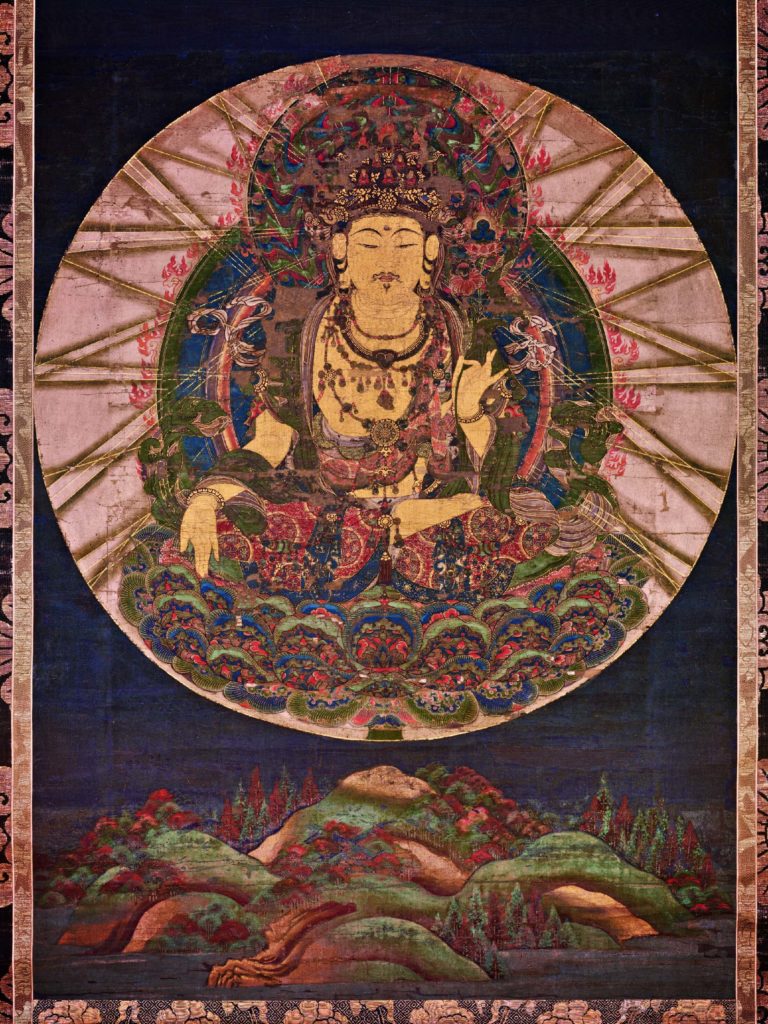











This painting embodies the artistic style of the 13th-century Kamakura period. For example, the bodhisattva has long slit eyes, a firm body, waving long cloth, and ornamental ribbons hanging from the sides of a crown. Although this painting appears decorative, the blue, green, and red colors perfectly contrast with each other.
The mountain landscape in the lower part of the painting may represent Mount Asama. It is located in Ise, a city in Mie Prefecture, on the island of Honshu. The city has a title that translates as “the Capital of the Kami”. The shrines at Ise are dismantled and rebuilt to the same specifications every twenty years.
The artist created the painting with Kokuzo Bosatsu for the initiation into the esoteric rites. This work is a type of honji suijaku, literally meaning the “home of a Shinto god”. This phrase refers to a widely accepted belief that Indian Buddhist deities choose to appear in Japan as native kami. The two entities form an indivisible whole called gongen.
For example, this painting depicts the Buddhist identity of a Shinto deity. He is often shown flanked by the two Shinto deities, Amaterasu, the Sun Goddess, and her brother, Susanoo, the Storm God. It feels like Kokuzo Bosatsu is looking from space at another bodhisattva, Vajrapani, who represents the power of all the Buddhas.
Vajrapani is the bodhisattva and the Holder of the Vajra. The vajra symbolizes the potent indestructibility of Buddhist teachings. He stands among all the serene, meditative bodhisattvas, wreathed in flame with a fierce pose and face. In fact, he is one of the earliest bodhisattvas in the Mahayana tradition. He is sometimes called the wrathful bodhisattva, however he embodies forceful energy rather than anger.
The followers of tantric Buddhist practices in the Himalayan region worship Vajrapani. Although he is a bodhisattva, at the same time he is also a protector deity. In China and Japan, he is not widely venerated and only appears in the mandalas of the esoteric schools.
To many Buddhists, his figure signifies the removal of obstacles. Moreover, Vajrapani conquers negative forces through fierce determination, symbolized by the vajra that he holds. In early legends, he was the guardian of the nagas, or serpent deities. He protected them against their enemies, the garudas, or bird-like deities.
In one of the stories, the Buddhas tried to hide poison from evil demons who were going to destroy humankind. While they searched for the antidote, the Buddhas asked Vajrapani to guard the poison. Nevertheless, a demon stole the poison from him. Afterward, the gods punished Vajrapani by making him drink water contaminated with poison, which turned him blue.
Tibetan Buddhism played a prominent role in the courts of the Yuan (1279–1638) and Ming (1368–1644) dynasties in China. As a result, artists created many Tibetan-style Buddhist works. Here, a Tibetan composition depicts a wrathful form of Vajrapani.
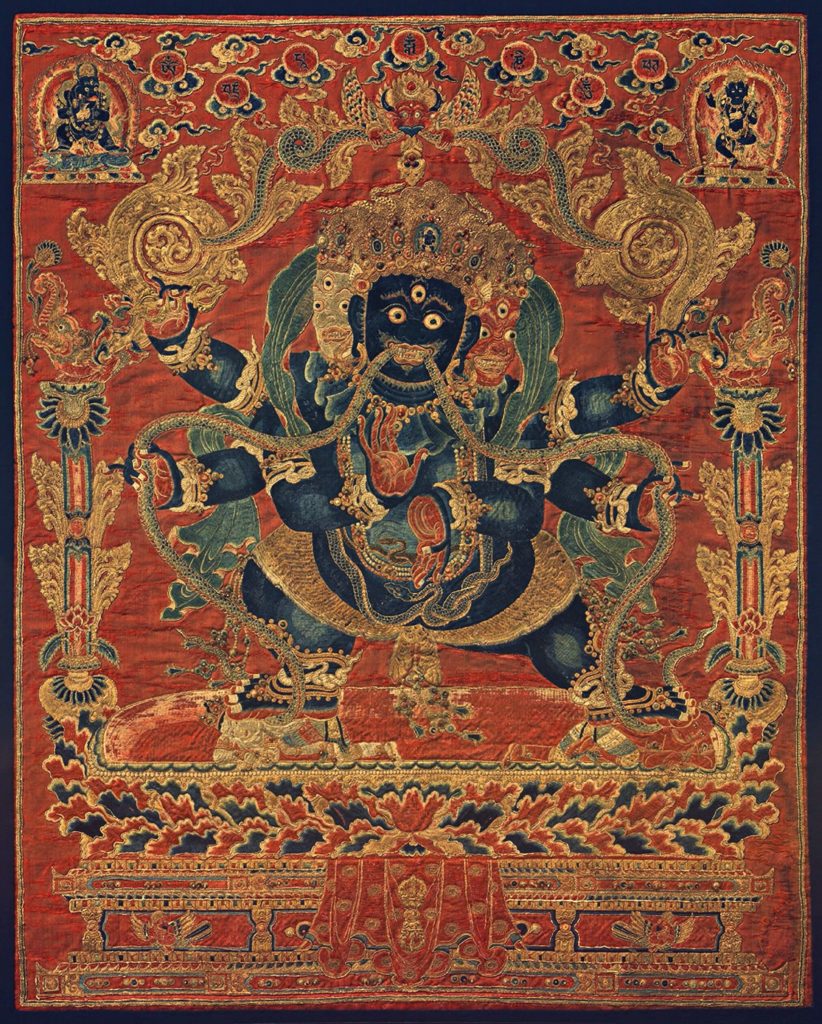











The Tibetan lotus and vase columns feature a garuda, naga, and sea monsters or makara. The artist combined these elements with Chinese-style clouds, holding disks that present Vajrapani’s mantra. Small coral beads and seed pearls appear on the central deity’s ornaments.
Rather than seeking to merely destroy desire and anger, tantric practices transform these obstacles into instruments of enlightenment. These methods require initiation by a guru, and if practitioners perform rituals correctly, they can attain Buddhahood in this lifetime.
Within temples, terrifying forms of local protectors, and various buddhas occupy a separate wrathful shrine, gonkhang or “protector’s house.” The followers believe that wrathful deities reside within these images. Therefore, often only with special initiations can one access the gonkhang.
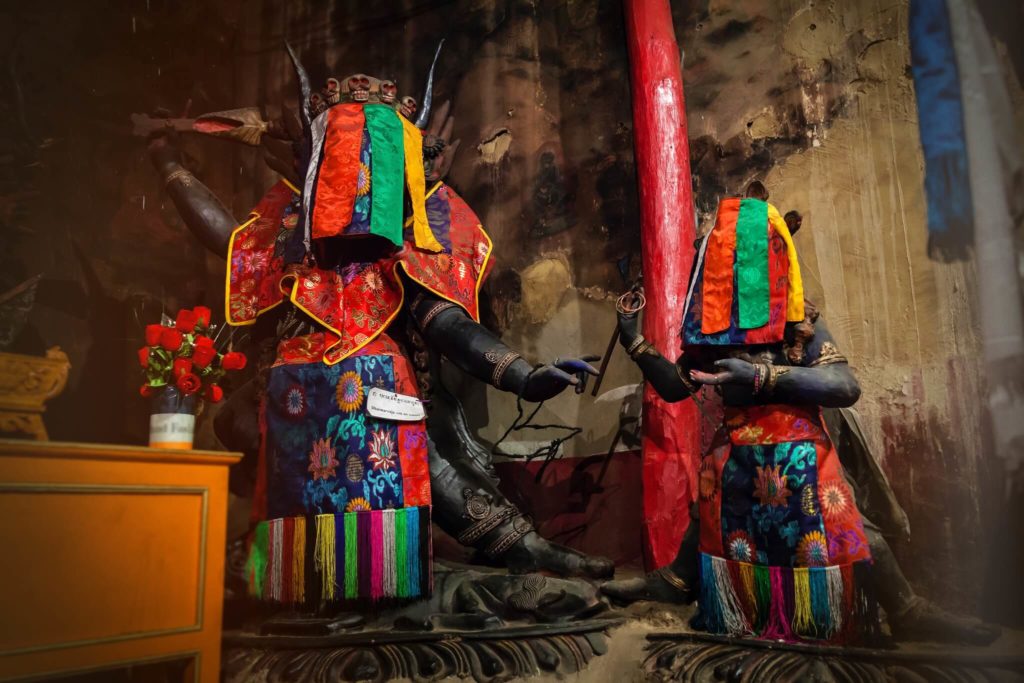











Even in open wrathful shrines, images of deities are veiled to protect the viewers. Grotesque offerings, such as flayed skins, that appease fearsome protectors can decorate a gonkhang’s walls. Nevertheless, these fearsome figures direct their energy toward eliminating negativity. Luckily, Vajrapani has a fellow who can lend a hand. Sarvanivarana-Vishkambhin is another bodhisattva who can assist him in removing all obstacles.
Believers invoke Sarvanivarana-Vishkambhin to eliminate all the obstacles and to ensure a successful meditation. In Sanskrit, the word “sarva” means “all” or “everything”, the word “nivarana” refers to hindrances or obstacles, and “vishkambhin” suggests blocking. Therefore, the full name of this bodhisattva means the “remover of all obstacles”. In Hindu mythology, there is also a remover of obstacles, and its believers widely worship Ganesh, represented by the head of an elephant.
The five mental obstacles are desire, hostility, laziness, distraction or worry, and doubts about faith. In Buddhism, faith arises from accumulated experience and reasoning. It centers on belief in the Three Jewels. They include the Buddha, the dharma or teachings of the Buddha, and the sangha or monastic community.
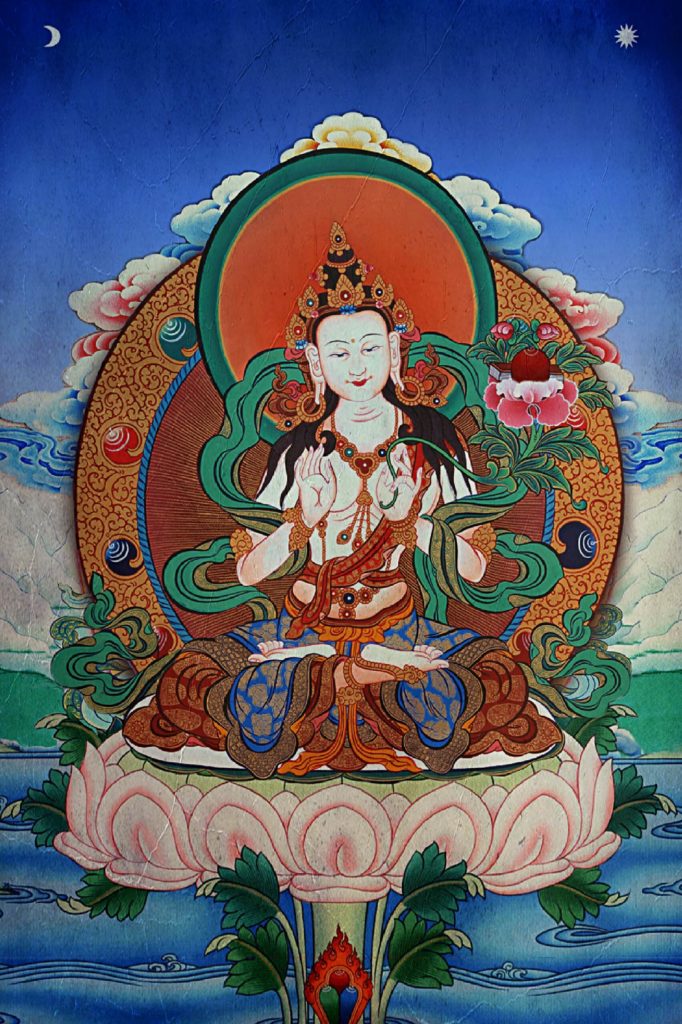











This bodhisattva appears in the Lotus Sutra, in which he pays homage to Avalokiteshvara. In the painting, Sarvanivarana-Vishkambhin is white, implying that he can relieve calamities. He has a flower in his left hand, upon which lies a book, symbolizing wisdom, and a wish-fulfilling jewel or cintamani.
His right hand is in the gesture granting the absence of fear or abhayamudra mudra. This mudra has the power of giving tranquility and the absence of fear to all beings. While removing obstacles, Sarvanivarana-Vishkambhin is preparing for the arrival of Maitreya or the Future Buddha.
Maitreya was the disciple of Shakyamuni Buddha. Maitreya’s name comes from the Sanskrit word “maitri”, which means “loving-kindness”. The Buddha predicted that Maitreya would become the next incarnate Buddha in the distant future. He will appear in this world at a time when the teachings of the present Buddha have disappeared.
Until then, Maitreya sits in the Tushita heaven of our human realm of desire. The beings in this heaven know satisfaction in the pursuit of pleasure, having transcended insatiable desire. Moreover, they have a life span of four thousand years, each day of which is equal to four hundred years in the human world. There, Maitreya contemplates how to save all suffering beings. Many of his followers believe that it is our job to prepare the world for him.
In this sculpture, Maitreya wears the jewels and garments appropriate for his divine position. The now missing stem of a lotus was above the left shoulder of the bodhisattva. (The brackets that held the stems of the lotuses are visible on the outside of the upper arms.) One of the lotuses could support the vase of purification or kundika filled with the nectar of enlightenment that washes away defilement.
Maitreya’s other main attribute was the eight-spoke dharma wheel that symbolizes the teachings of the path to enlightenment. His right hand is in the gesture of teaching or dharmachakra mudra. He holds his left hand in the gesture of meditation or dhyana mudra showing that purification arises out of the meditative state.
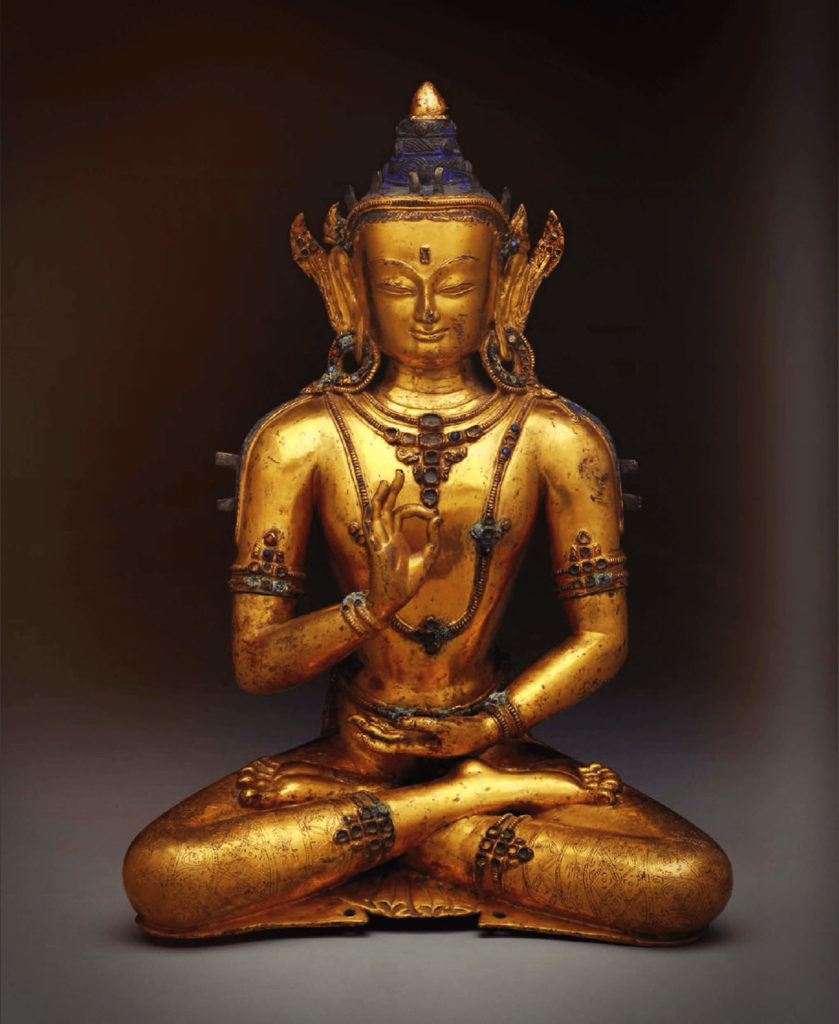











Meditative discipline is based upon strict ethical behavior that avoids non-virtuous actions of the body, speech, and mind. Only then the mind can settle on a virtuous object and attain a state of perfect stability and clarity, called samatha. Thus, this image of Maitreya embodies the balance, beauty, and glory of this state.
Maitreya’s third eye represents his transcended wisdom. The now missing jewel in his forehead symbolizes this virtue. Furthermore, his face reflects the profound confidence that arises from the inner calm and wisdom of the enlightened state.
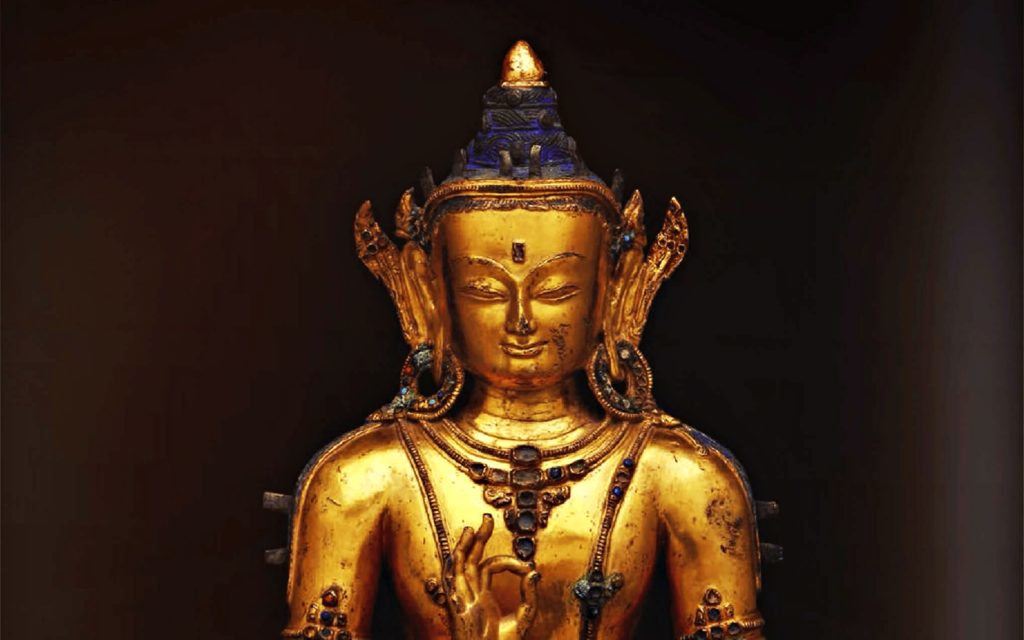











Many images of this bodhisattva have large eyes. This implies that Maitreya is a transcended being who manifests in a human-like form to interact with ordinary beings who cannot perceive him in his true form. The blue hair in a large topknot signifies the cranial protuberance or ushnisha of a fully enlightened being. Bejeweled ornaments frame the head, and large earrings with jewels hang from the long earlobes.
Delicate patterns of auspicious signs and sacred motifs adorn the lower garment. These symbolize the thirty-two major and eighty minor marks, or lakshanas, of a fully enlightened being. Maitreya’s lotus throne, showing his compassionate connection with the world, was cast separately from the body and has since been lost. For the time being, Maitreya inhabits the space with great bodhisattvas who possess extraordinary skills and have immeasurable power of compassion.
Although the Eight Great Bodhisattvas all have the same powers, each one displays perfection in a specific area. For example, Avalokiteshvara embodies compassion, while Manjushri concentrates on wisdom. Kshitigarbha saves beings from torment and guards them.












Further, Samantabhadra represents compassion and the Law of the Buddha. Akashagarbha can help followers recover from their errors. Vajrapani, with his power and energy, tramples negativity. Sarvanivarana-Vishkambhin removes obstacles. Finally, Maitreya who embraces loving-kindness is waiting to appear as the Future Buddha.
Meanwhile, anyone can embark on the bodhisattva path as it is not restrictive. When one intends to take on a bodhisattva practice, one can join the ranks of the bodhisattvas. We may learn models that allow us to find the elements of our own enlightening nature. By following teachings about generosity, patience, ethical conduct, and meditative balance, we can benefit others.
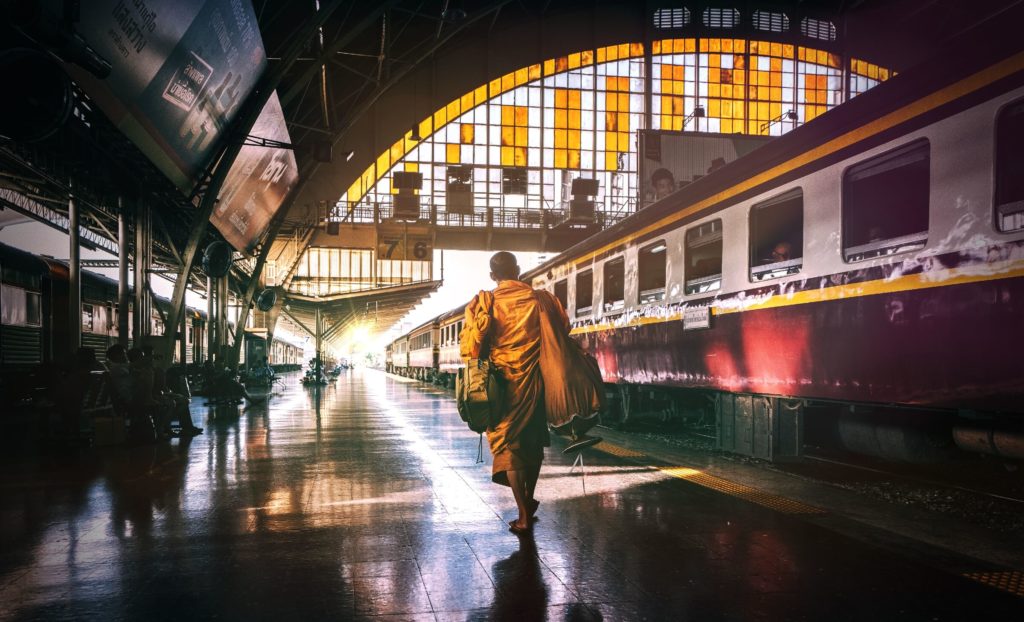











Compassion is a state of mind that wants others to be free from suffering. It must have both wisdom and loving-kindness. All bodhisattvas practice the virtues of compassion, generosity, and wisdom. The diverse artistic representations of these enlightened beings exemplify their limitless compassion. Bodhisattvas can help us to think about how to become more compassionate beings and push our own limits. They can nourish these qualities in us as we study, practice with, or offer devotion to them. Finally, we may discover that we have become bodhisattvas by ourselves.
DailyArt Magazine needs your support. Every contribution, however big or small, is very valuable for our future. Thanks to it, we will be able to sustain and grow the Magazine. Thank you for your help!